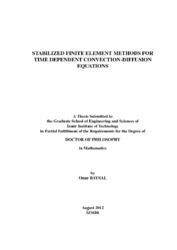Please use this identifier to cite or link to this item:
https://hdl.handle.net/11147/2934| Title: | Stabilized finite element methods for time dependent convection-diffusion equations | Authors: | Baysal, Onur | Advisors: | Tanoğlu, Gamze | Publisher: | Izmir Institute of Technology | Abstract: | In this thesis, enriched finite element methods are presented for both steady and unsteady convection diffusion equations. For the unsteady case, we follow the method of lines approach that consists of first discretizing in space and then use some time integrator to solve the resulting system of ordinary differential equation. Discretization in time is performed by the generalized Euler finite difference scheme, while for the space discretization the streamline upwind Petrov-Galerkin (SUPG), the Residual free bubble (RFB), the more recent multiscale (MS) and specific combination of RFB with MS (MIX) methods are considered. To apply the RFB and the MS methods, the steady local problem, which is as complicated as the original steady equation, should be solved in each element. That requirement makes these methods quite expensive especially for two dimensional problems. In order to overcome that drawback the pseudo approximation techniques, which employ only a few nodes in each element, are used. Next, for the unsteady problem a proper adaptation recipe, including these approximations combined with the generalized Euler time discretization, is described. For piecewise linear finite element discretization on triangular grid, the SUPG method is used. Then we derive an efficient stability parameter by examining the relation of the RFB and the SUPG methods. Stability and convergence analysis of the SUPG method applied to the unsteady problem is obtained by extending the Burman’s analysis techniques for the pure convection problem. We also suggest a novel operator splitting strategy for the transport equations with nonlinear reaction term. As a result two subproblems are obtained. One of which we may apply using the SUPG stabilization while the other equation can be solved analytically. Lastly, numerical experiments are presented to illustrate the good performance of the method. | Description: | Thesis (Doctoral)--Izmir Institute of Technology, Mathematics, Izmir, 2012 Includes bibliographical references (leaves: 92-96) Text in English; Abstract: Turkish and English x, 96 leaves |
URI: | http://hdl.handle.net/11147/2934 |
| Appears in Collections: | Phd Degree / Doktora |
Files in This Item:
| File | Description | Size | Format | |
|---|---|---|---|---|
| T001035.pdf | DoctoralThesis | 2.87 MB | Adobe PDF |  View/Open |
CORE Recommender
Page view(s)
184
checked on Sep 23, 2024
Download(s)
114
checked on Sep 23, 2024
Google ScholarTM
Check
Items in GCRIS Repository are protected by copyright, with all rights reserved, unless otherwise indicated.